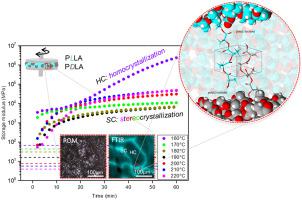Additive Manufacturing ( IF 11.0 ) Pub Date : 2020-10-19 , DOI: 10.1016/j.addma.2020.101665 Varun Srinivas , Francesca Bertella , Catharina S.J. van Hooy-Corstjens , Bas van Leeuwen , E.G.M. Craenmehr , Dario Cavallo , Sanjay Rastogi , Jules A.W. Harings

|
To understand the relation of molecular design of powder formulations in the realization of effective stress transfer at sintered polymer – polymer interfaces by the concept of interfacial stereocomplex crystallization in a broad temperature range, the effect of temperature and molar mass ratio are studied in heterogeneous poly(lactide) melt-states. Whereas the stereocomplex crystallization rate is dictated by supercooling and relative viscosities, the length-scales depend on the formation of crystalline stereocomplex domains connected via amorphous regions resulting in network formation, gelation. Upon gelation, further diffusion is impeded, which is supported by rheometry, DSC and FTIR imaging. When the initial relative viscosity between the PLA fractions is low, the time to reach critical network density is high. On the contrary, the length-scales of stereocomplex crystallization and ultimate mechanical stiffening are strongly influenced by the chosen temperature and molar mass ratio of the PLA fractions. Occurrence of interfacial stereocomplex crystallization under the non-isothermal conditions of selective laser sintering is validated. This fundamental understanding on the time- and length-scales of interfacial diffusion, successive stereocomplex crystallization, and nucleation of homocrystals upon further cooling, assists in the technical assurance of mechanically reinforced polymer-polymer interfaces – not only in sintered but in additively manufactured polymeric constructs in general.
中文翻译:

用于增强(激光)烧结焊缝的非均相聚合物粉末配方中的界面立体络合
为了理解在宽温度范围内界面立体配合物结晶的概念,粉末配方的分子设计与在聚合物-聚合物界面上有效应力转移的实现之间的关系,研究了温度和摩尔质量比在非均相聚(丙交酯)熔融态。尽管立体复合物的结晶速率由过冷度和相对粘度决定,但长度尺度取决于通过无定形区域连接的结晶立体复合物结构域的形成,从而导致网络形成,凝胶化。胶凝后,阻止了进一步的扩散,这受到流变仪,DSC和FTIR成像的支持。当PLA馏分之间的初始相对粘度较低时,达到临界网络密度的时间也较长。反之,立体复合物结晶和最终机械刚度的长度尺度在很大程度上受所选的PLA组分温度和摩尔质量比的影响。验证了在选择性激光烧结的非等温条件下界面立体复合物结晶的发生。对界面扩散的时间和长度尺度,连续的立体配合物结晶以及进一步冷却时均晶成核的基本了解,不仅可以在烧结中,而且可以在增材制造的聚合物结构中为机械增强的聚合物-聚合物界面提供技术保证。一般来说。验证了在选择性激光烧结的非等温条件下界面立体复合物结晶的发生。对界面扩散的时间和长度尺度,连续的立体配合物结晶以及进一步冷却时均晶成核的基本了解,不仅可以在烧结中,而且可以在增材制造的聚合物结构中为机械增强的聚合物-聚合物界面提供技术保证。一般来说。验证了在选择性激光烧结的非等温条件下界面立体复合物结晶的发生。对界面扩散的时间和长度尺度,连续的立体配合物结晶以及进一步冷却时均晶成核的基本了解,不仅可以在烧结中,而且可以在增材制造的聚合物结构中为机械增强的聚合物-聚合物界面提供技术保证。一般来说。


























 京公网安备 11010802027423号
京公网安备 11010802027423号